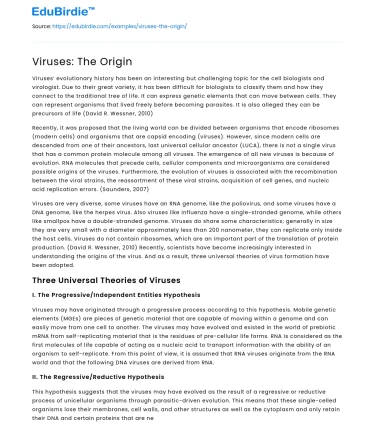Viruses’ evolutionary history has been an interesting but challenging topic for the cell biologists and virologist. Due to their great variety, it has been difficult for biologists to classify them and how they connect to the traditional tree of life. It can express genetic elements that can move between cells. They can represent organisms that lived freely before becoming parasites. It is also alleged they can be precursors of life (David R. Wessner, 2010)
Recently, it was proposed that the living world can be divided between organisms that encode ribosomes (modern cells) and organisms that are capsid encoding (viruses). However, since modern cells are descended from one of their ancestors, last universal cellular ancestor (LUCA), there is not a single virus that has a common protein molecule among all viruses. The emergence of all new viruses is because of evolution. RNA molecules that precede cells, cellular components and microorganisms are considered possible origins of the viruses. Furthermore, the evolution of viruses is associated with the recombination between the viral strains, the reassortment of these viral strains, acquisition of cell genes, and nucleic acid replication errors. (Saunders, 2007)
Viruses are very diverse, some viruses have an RNA genome, like the poliovirus, and some viruses have a DNA genome, like the herpes virus. Also viruses like Influenza have a single-stranded genome, while others like smallpox have a double-stranded genome. Viruses do share some characteristics; generally in size they are very small with a diameter approximately less than 200 nanometer, they can replicate only inside the host cells. Viruses do not contain ribosomes, which are an important part of the translation of protein production. (David R. Wessner, 2010) Recently, scientists have become increasingly interested in understanding the origins of the virus. And as a result, three universal theories of virus formation have been adopted.
Three Universal Theories of Viruses
I. The Progressive/Independent Entities Hypothesis
Viruses may have originated through a progressive process according to this hypothesis. Mobile genetic elements (MGEs) are pieces of genetic material that are capable of moving within a genome and can easily move from one cell to another. The viruses may have evolved and existed in the world of prebiotic mRNA from self-replicating material that is the residues of pre-cellular life forms. RNA is considered as the first molecules of life capable of acting as a nucleic acid to transport information with the ability of an organism to self-replicate. From this point of view, it is assumed that RNA viruses originate from the RNA world and that the following DNA viruses are derived from RNA.
II. The Regressive/Reductive Hypothesis
This hypothesis suggests that the viruses may have evolved as the result of a regressive or reductive process of unicellular organisms through parasitic-driven evolution. This means that these single-celled organisms lose their membranes, cell walls, and other structures as well as the cytoplasm and only retain their DNA and certain proteins that are necessary for their survival as parasites in other cells.
III. The Escape Theory
The third hypothesis, the 'Escape Theory,' proposes that the viruses are might have originated from a small fragment of genetic material that was later created by the horizontal gene transfer (HGT) gene. (Forterre P, 2006) Some scientists believed that HGTs are the predominant forces generated by many viral genomes. The plasmids and MGEs are extracellular genetic material that can enter and exit the cells of different genomes. This theory can give an understanding of the possibilities of escape by the genetic elements.
Some Current Views Regarding the Origin and Evolution of Viruses
The origin and evolution of viruses still remains very controversial, and many authors have recently argued that RNA’s evolution in LUCA might have occurred before cells were even discovered.
- According to Forterre, the evolution of the world of RNA derives from the effects between cells and viruses, which resulted in the formation of the prokaryotes and eukaryotes from three cellular domains; archaea, bacteria and eukaryotes. Forterre & Prangishvili also suggest that viral genes may have originated in the virosphere during replication of viral genomes that were recruited from cellular ancestries which are extinct now. Jalasvuori & Bamford suggests that “The Life” begun with protoviruses infecting non-living vesicles that later on became the protocells. (Jalasvuori M, (2008))
- R Bandea hypothesizes a fusion model that represents a virus produced by merging a host cell with a parasitic cell type to provide the virus with better access to host resources in a scenario where the protoviruses’ membranes may have been surrounded. The loss of the inner membrane and cell structure of the cell allows the parasite to fully enter the precursors to survive and evolve. Fusion theory is supported by evidence that the new strain of the virus comes from cellular parasitic species and this process might still be active. (CI, (2009) )
To answer the question “Where does viruses come from?” it's not easy to answer. To date, there is no definite explanation as regards to the origins of viruses. Viruses may have arisen from MGE, which has the ability to move between cells and may be the progenies of previously free-living organisms that adapted a parasitic replication strategy. The idea of viruses that “Life” arose from them offers some very interesting possibilities. Perhaps today’s viruses have appeared through various mechanisms but still remains to be uncovered. Ongoing research can give us consistent answers via the fields of genomics, microbiology, and biology that can give more insight to its evolutionary origin.






 Stuck on your essay?
Stuck on your essay?

